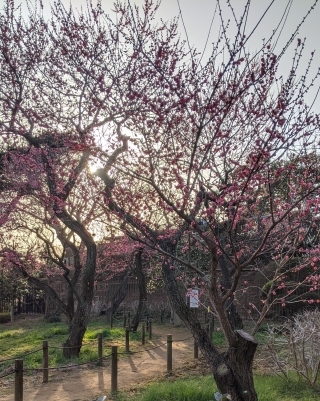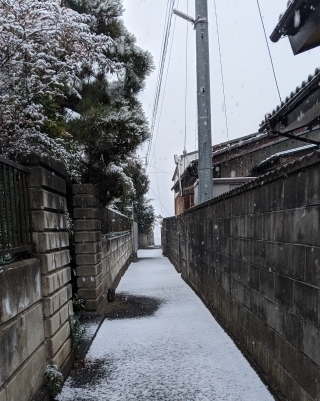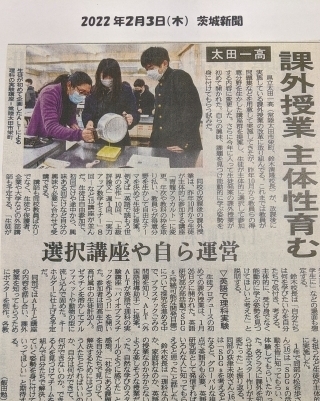JET Programme Series: Welcome to Hitachiota! - Amrita Mahabir
2022/3/11




Your first thought upon reading the title might be “Where?”. I admit, I too was unaware of Ibaraki prefecture let alone Hitachiota until I arrived here in December 2021. Since then, Hitachiota has been a (figuratively) warm and welcoming place where I have been able to experience the slow calm of the Japanese countryside. The quiet and relaxed pace is almost reminiscent of life in rural Trinidad, that is, until the winds of winter sharply remind me that I am most certainly not in the Caribbean.
My first real experience of winter was a challenge, but a welcome one. While Ibaraki does not usually experience snowfall, I was fortunate enough to experience one of those rare days where the countryside was blanketed in in white, if only for a brief moment. In true Trini fashion, I went into full “never see, come see” mode, walking in and enjoying the gentle snowfall. Needless to say, I started sniffling the day after my fun in the snow.
I am stationed at one school which comprises of both a junior and senior high school. The rambunctiousness and somewhat carefree nature of the junior students is in stark contrast to the quiet studious nature of my senior students. Or so I thought, until I realized that the senior students can be just as excitable; they simply need to be given an opportunity. I absolutely enjoy providing them with said opportunities and observing as they break out of their usual conservative shells. My most standout experience thus far, has been teaching science classes in English. I was asked to conduct a bioplastic experiment for my English club students, which was well received by both students and teachers. I appreciate that I am not only gaining teaching experience, but that I am also able to incorporate my Biochemistry background.
Between teaching and the wintery weather, I have not been able to venture too far from Hitachiota (the cold most certainly bothers me). However, Hitachiota itself boasts and interesting history and connection with both Mito city, the capital of Ibaraki, and Edo-era Tokyo. The Mito domain housed a branch of the Tokugawa clan, members of whom travelled from Edo-era Mito to Hitachiota for rest, repose and eventually retirement at the famous Seizansou. Mito city is also home to the famous Kairakuen park (which was founded by the Tokugawa family), where there is a collection of the many varieties of plum blossom trees. Plum blossoms bloom approximately one month before cherry blossoms, and seeing hundreds of trees in full bloom is truly a breathtaking sight.
While life in Hitachiota and Mito may not be as exciting as living in Tokyo, Ibaraki prefecture has welcomed me with open arms. I look forward to travelling and exploring both within my prefecture and throughout the rest of Japan during my stay.
JET Series: Welcome to Hitachiota! (Japanese Embassy's Facebook)
JET Programme Series Archives
My first real experience of winter was a challenge, but a welcome one. While Ibaraki does not usually experience snowfall, I was fortunate enough to experience one of those rare days where the countryside was blanketed in in white, if only for a brief moment. In true Trini fashion, I went into full “never see, come see” mode, walking in and enjoying the gentle snowfall. Needless to say, I started sniffling the day after my fun in the snow.
I am stationed at one school which comprises of both a junior and senior high school. The rambunctiousness and somewhat carefree nature of the junior students is in stark contrast to the quiet studious nature of my senior students. Or so I thought, until I realized that the senior students can be just as excitable; they simply need to be given an opportunity. I absolutely enjoy providing them with said opportunities and observing as they break out of their usual conservative shells. My most standout experience thus far, has been teaching science classes in English. I was asked to conduct a bioplastic experiment for my English club students, which was well received by both students and teachers. I appreciate that I am not only gaining teaching experience, but that I am also able to incorporate my Biochemistry background.
Between teaching and the wintery weather, I have not been able to venture too far from Hitachiota (the cold most certainly bothers me). However, Hitachiota itself boasts and interesting history and connection with both Mito city, the capital of Ibaraki, and Edo-era Tokyo. The Mito domain housed a branch of the Tokugawa clan, members of whom travelled from Edo-era Mito to Hitachiota for rest, repose and eventually retirement at the famous Seizansou. Mito city is also home to the famous Kairakuen park (which was founded by the Tokugawa family), where there is a collection of the many varieties of plum blossom trees. Plum blossoms bloom approximately one month before cherry blossoms, and seeing hundreds of trees in full bloom is truly a breathtaking sight.
While life in Hitachiota and Mito may not be as exciting as living in Tokyo, Ibaraki prefecture has welcomed me with open arms. I look forward to travelling and exploring both within my prefecture and throughout the rest of Japan during my stay.
JET Series: Welcome to Hitachiota! (Japanese Embassy's Facebook)
JET Programme Series Archives
